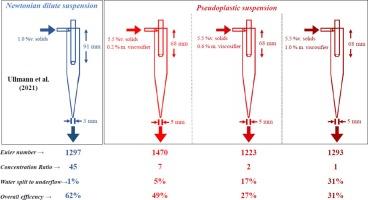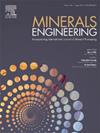Effect of solids concentration and operational variables on the performance of a geometrically optimized concentrator hydrocyclone employing a pseudoplastic fluid
IF 4.9
2区 工程技术
Q1 ENGINEERING, CHEMICAL
引用次数: 0
Abstract
The employment of hydrocyclones in thickening operations is an attractive option when compared to centrifuges and filters due to their low operating, maintenance, and acquisition costs. However, the performance of hydrocyclone separation is impaired as the concentration of solids and the viscosity of the suspension increases. Using geometric optimization techniques, the Federal University of Uberlândia developed one concentrator hydrocyclone named HC. When working with diluted and Newtonian slurries, the HC could generate a stream 45 times more concentrated than the one fed into it. In this study, the HC performance was evaluated when operating pseudoplastic fluids containing up to 10% solids by volume. The combination of the underflow diameter and vortex finder length with an adequate supply of pressure energy maintained the thickening potential of the HC even when the rheology of the fluid was changed. For different working suspensions, the HC hydrocyclone achieved a minimum water split to underflow of 5%, a maximum concentration ratio of 7.0, and a maximum efficiency of 49%. The encouraging results obtained by the HC validated the benefits of the geometric optimization, as they point to a significant advance in the thickening operation of non–Newtonian sludges with a flow behavior index greater than 0.5.

固体浓度和操作变量对采用假塑性流体的几何优化浓缩水力旋流器性能的影响
与离心机和过滤器相比,水力旋流器的运行、维护和购置成本较低,因此在浓缩作业中使用水力旋流器是一种极具吸引力的选择。然而,随着固体浓度和悬浮液粘度的增加,水力旋流器的分离性能会受到影响。乌伯兰迪亚联邦大学利用几何优化技术开发了一种名为 HC 的浓缩水力旋流器。在处理稀释的牛顿泥浆时,HC 能产生比输入泥浆浓度高 45 倍的液流。本研究评估了 HC 在处理固体含量高达 10% 的假塑性流体时的性能。即使流体的流变性发生变化,底流直径和涡流探测器长度与充足的压能供应相结合,也能保持 HC 的增稠潜力。对于不同的工作悬浮液,HC 水力旋流器的最小分水率为 5%,最大浓缩比为 7.0,最高效率为 49%。HC 水力旋流器取得的令人鼓舞的结果验证了几何优化的益处,因为这些结果表明,在流动行为指数大于 0.5 的非牛顿流体淤泥的浓缩操作方面取得了重大进展。
本文章由计算机程序翻译,如有差异,请以英文原文为准。
求助全文
约1分钟内获得全文
求助全文
来源期刊

Minerals Engineering
工程技术-工程:化工
CiteScore
8.70
自引率
18.80%
发文量
519
审稿时长
81 days
期刊介绍:
The purpose of the journal is to provide for the rapid publication of topical papers featuring the latest developments in the allied fields of mineral processing and extractive metallurgy. Its wide ranging coverage of research and practical (operating) topics includes physical separation methods, such as comminution, flotation concentration and dewatering, chemical methods such as bio-, hydro-, and electro-metallurgy, analytical techniques, process control, simulation and instrumentation, and mineralogical aspects of processing. Environmental issues, particularly those pertaining to sustainable development, will also be strongly covered.
 求助内容:
求助内容: 应助结果提醒方式:
应助结果提醒方式:


